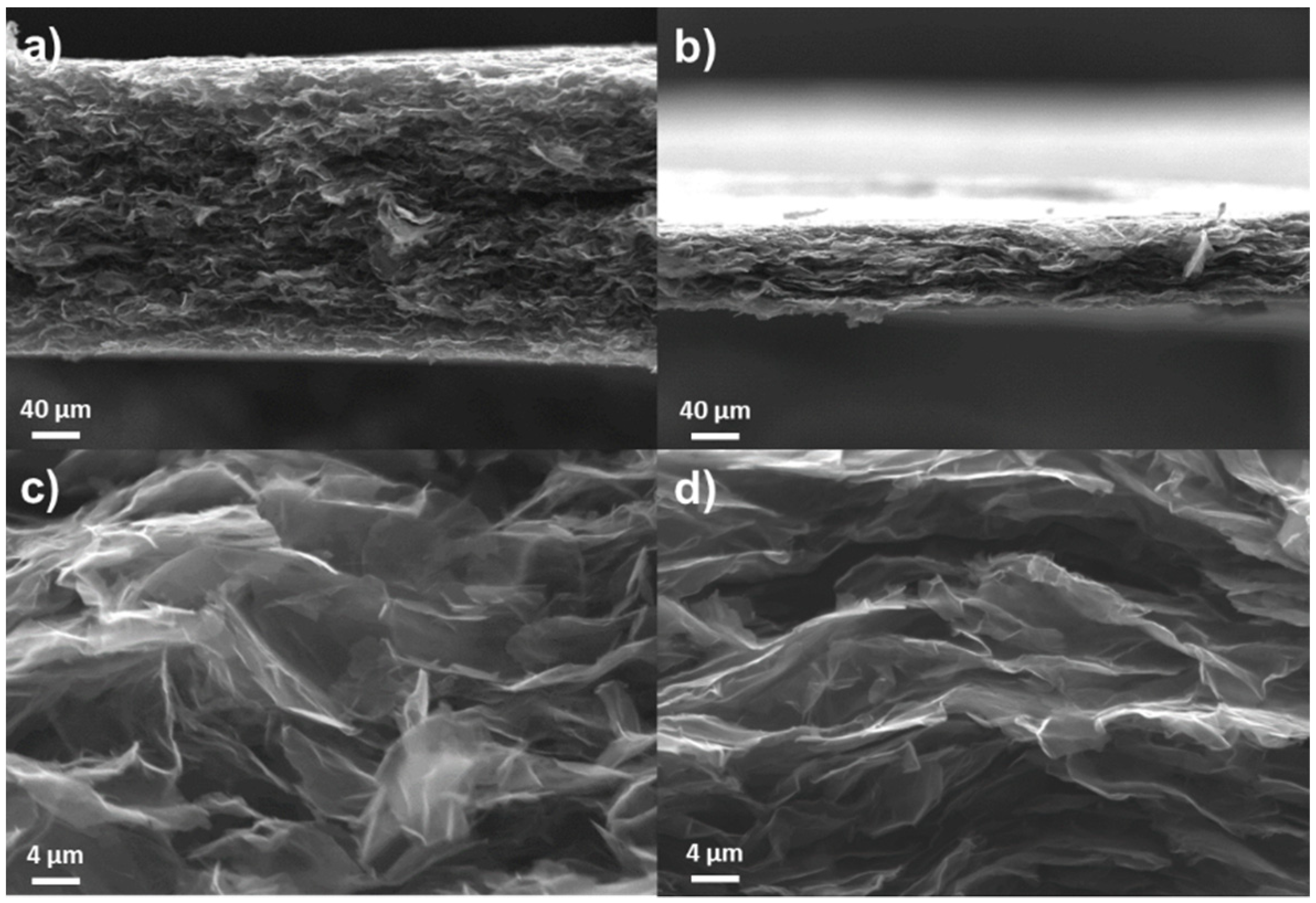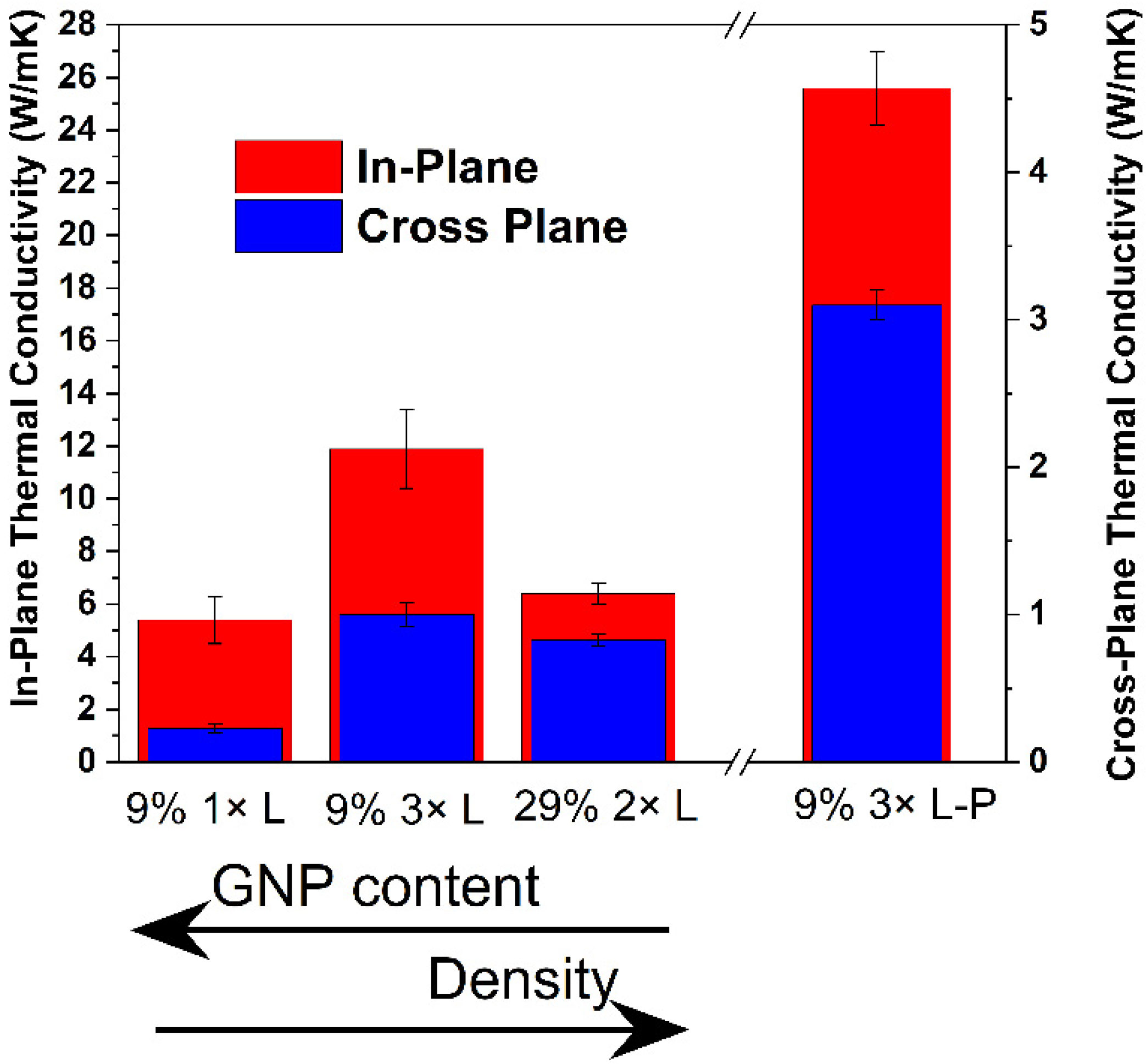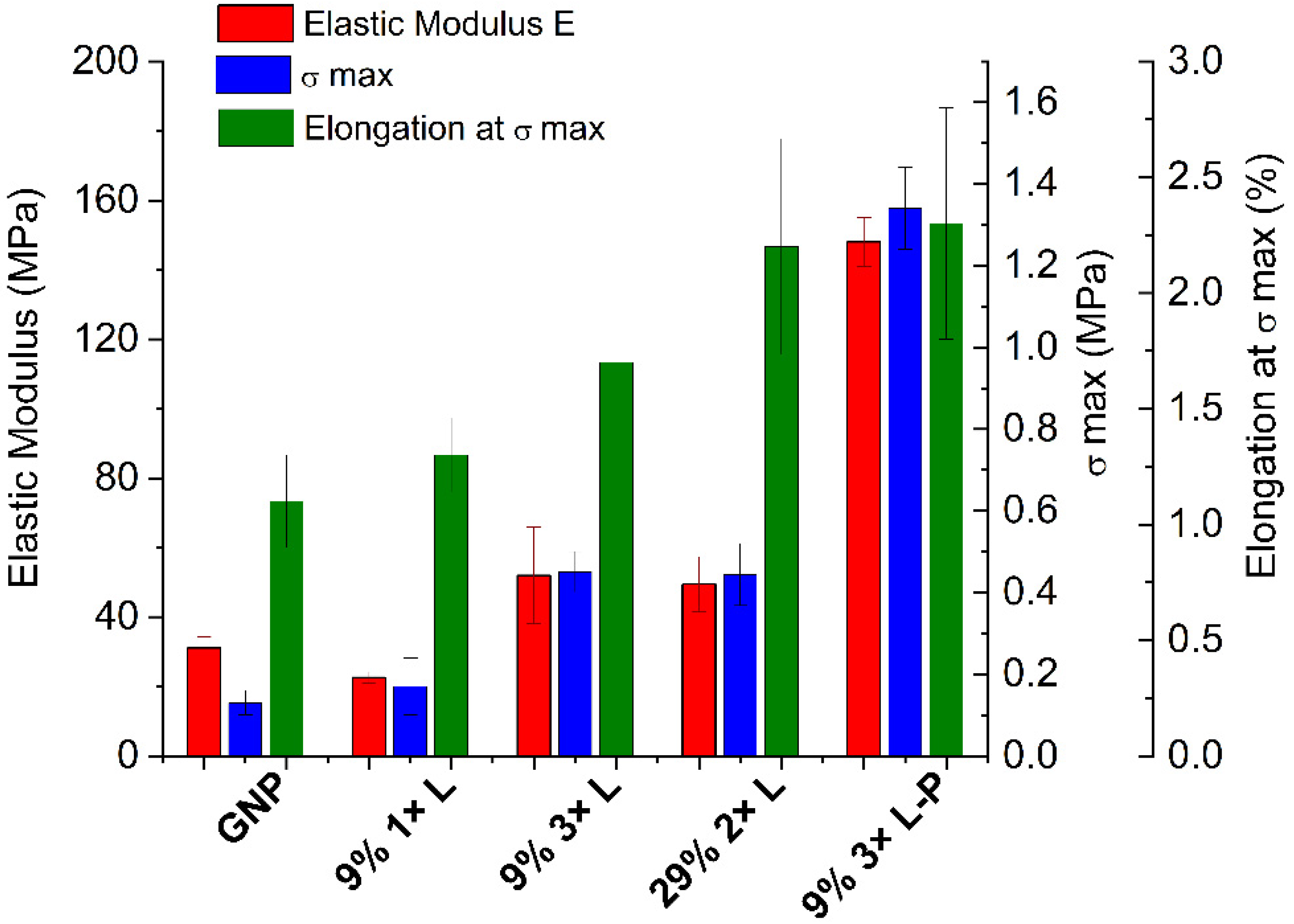Flexible and High Thermal Conductivity Composites Based on Graphite Nanoplates Paper Impregnated with Polydimethylsiloxane
Abstract
:1. Introduction
2. Materials and Methods
2.1. Materials
2.2. Nanopaper Production
2.3. Characterization Methods
3. Results and Discussion
3.1. Characterization of Pristine GNP Nanopapers
3.2. Characterization of GNP Nanopapers Impregnated with PDMS
4. Conclusions
Supplementary Materials
Author Contributions
Funding
Institutional Review Board Statement
Informed Consent Statement
Data Availability Statement
Acknowledgments
Conflicts of Interest
References
- Gadipelli, S.; Guo, Z.X. Graphene-based materials: Synthesis and gas sorption, storage and separation. Prog. Mater. Sci. 2015, 69, 1–60. [Google Scholar] [CrossRef] [Green Version]
- Novoselov, K.S.; Fal’ko, V.I.; Colombo, L.; Gellert, P.R.; Schwab, M.G.; Kim, K. A roadmap for graphene. Nature 2012, 490, 192–200. [Google Scholar] [CrossRef] [PubMed]
- Ferrari, A.C.; Bonaccorso, F.; Fal’ko, V.; Novoselov, K.S.; Roche, S.; Boggild, P.; Borini, S.; Koppens, F.H.; Palermo, V.; Pugno, N.; et al. Science and technology roadmap for graphene, related two-dimensional crystals, and hybrid systems. Nanoscale 2015, 7, 4598–4810. [Google Scholar] [CrossRef] [Green Version]
- Backes, C.; Abdelkader, A.M.; Alonso, C.; Andrieux-Ledier, A.; Arenal, R.; Azpeitia, J.; Balakrishnan, N.; Banszerus, L.; Barjon, J.; Bartali, R.; et al. Production and processing of graphene and related materials. 2D Mater. 2020, 7, 022001. [Google Scholar] [CrossRef]
- Colonna, S.; Battegazzore, D.; Eleuteri, M.; Arrigo, R.; Fina, A. Properties of Graphene-Related Materials Controlling the Thermal Conductivity of Their Polymer Nanocomposites. Nanomaterials 2020, 10, 2167. [Google Scholar] [CrossRef] [PubMed]
- Burger, N.; Laachachi, A.; Mortazavi, B.; Ferriol, M.; Lutz, M.; Toniazzo, V.; Ruch, D. Alignments and network of graphite fillers to improve thermal conductivity of epoxy-based composites. Int. J. Heat Mass Transf. 2015, 89, 505–513. [Google Scholar] [CrossRef]
- Burger, N.; Laachachi, A.; Ferriol, M.; Lutz, M.; Toniazzo, V.; Ruch, D. Review of thermal conductivity in composites: Mechanisms, parameters and theory. Prog. Polym. Sci. 2016, 61, 1–28. [Google Scholar] [CrossRef]
- Chen, H.; Ginzburg, V.V.; Yang, J.; Yang, Y.; Liu, W.; Huang, Y.; Du, L.; Chen, B. Thermal conductivity of polymer-based composites: Fundamentals and applications. Prog. Polym. Sci. 2016, 59, 41–85. [Google Scholar] [CrossRef]
- Di Pierro, A.; Mortazavi, B.; Fina, A. Molecular Junctions Enhancing Thermal Transport within Graphene Polymer Nanocomposite: A Molecular Dynamics Study. Nanomaterials 2021, 11, 2480. [Google Scholar] [CrossRef]
- Wang, Y.; Zhan, H.F.; Xiang, Y.; Yang, C.; Wang, C.M.; Zhang, Y.Y. Effect of Covalent Functionalization on Thermal Transport across Graphene–Polymer Interfaces. J. Phys. Chem. C 2015, 119, 12731–12738. [Google Scholar] [CrossRef] [Green Version]
- Balandin, A.A. Thermal properties of graphene and nanostructured carbon materials. Nat. Mater. 2011, 10, 569–581. [Google Scholar] [CrossRef] [PubMed] [Green Version]
- Tortello, M.; Colonna, S.; Bernal, M.; Gomez, J.; Pavese, M.; Novara, C.; Giorgis, F.; Maggio, M.; Guerra, G.; Saracco, G.; et al. Effect of thermal annealing on the heat transfer properties of reduced graphite oxide flakes: A nanoscale characterization via scanning thermal microscopy. Carbon 2016, 109, 390–401. [Google Scholar] [CrossRef] [Green Version]
- Colonna, S.; Monticelli, O.; Gomez, J.; Novara, C.; Saracco, G.; Fina, A. Effect of morphology and defectiveness of graphene-related materials on the electrical and thermal conductivity of their polymer nanocomposites. Polymer 2016, 102, 292–300. [Google Scholar] [CrossRef] [Green Version]
- Sheshkar, N.; Verma, G.; Pandey, C.; Sharma, A.K.; Gupta, A. Enhanced thermal and mechanical properties of hydrophobic graphite-embedded polydimethylsiloxane composite. J. Polym. Res. 2021, 28, 403. [Google Scholar] [CrossRef]
- Kong, K.T.S.; Mariatti, M.; Rashid, A.A.; Busfield, J.J.C. Enhanced conductivity behavior of polydimethylsiloxane (PDMS) hybrid composites containing exfoliated graphite nanoplatelets and carbon nanotubes. Compos. Part B Eng. 2014, 58, 457–462. [Google Scholar] [CrossRef]
- Zhao, Y.-H.; Zhang, Y.-F.; Bai, S.-L. High thermal conductivity of flexible polymer composites due to synergistic effect of multilayer graphene flakes and graphene foam. Compos. Part A Appl. Sci. Manuf. 2016, 85, 148–155. [Google Scholar] [CrossRef]
- Zhang, Q.; Xu, X.; Li, H.; Xiong, G.; Hu, H.; Fisher, T.S. Mechanically robust honeycomb graphene aerogel multifunctional polymer composites. Carbon 2015, 93, 659–670. [Google Scholar] [CrossRef]
- Tao, Z.; Wang, H.; Li, X.; Liu, Z.; Guo, Q. Expanded graphite/polydimethylsiloxane composites with high thermal conductivity. J. Appl. Polym. Sci. 2017, 134, 44843. [Google Scholar] [CrossRef]
- Oliva, J.; Mtz-Enriquez, A.; Oliva, A.; Ochoa-Valiente, R.; Garcia, C.; Pei, Q. Flexible graphene composites with high thermal conductivity as efficient heat sinks in high-power LEDs. J. Phys. D Appl. Phys. 2018, 52, 025103. [Google Scholar] [CrossRef]
- Han, B.; Song, J.; Hu, T.; Ye, H.; Xu, L. High thermal conductivity in polydimethylsiloxane composite with vertically oriented graphene nanosheets by liquid-phase exfoliation. Chem. Phys. Lett. 2020, 743, 137156. [Google Scholar] [CrossRef]
- Fang, H.; Zhao, Y.; Zhang, Y.; Ren, Y.; Bai, S.-L. Three-dimensional graphene foam-filled elastomer composites with high thermal and mechanical properties. ACS Appl. Mater. Interfaces 2017, 9, 26447–26459. [Google Scholar] [CrossRef]
- Zhao, Y.-H.; Wu, Z.-K.; Bai, S.-L. Study on thermal properties of graphene foam/graphene sheets filled polymer composites. Compos. Part A Appl. Sci. Manuf. 2015, 72, 200–206. [Google Scholar] [CrossRef]
- Renteria, J.D.; Ramirez, S.; Malekpour, H.; Alonso, B.; Centeno, A.; Zurutuza, A.; Cocemasov, A.I.; Nika, D.L.; Balandin, A.A. Strongly Anisotropic Thermal Conductivity of Free-Standing Reduced Graphene Oxide Films Annealed at High Temperature. Adv. Funct. Mater. 2015, 25, 4664–4672. [Google Scholar] [CrossRef]
- Shen, B.; Zhai, W.; Zheng, W. Ultrathin Flexible Graphene Film: An Excellent Thermal Conducting Material with Efficient EMI Shielding. Adv. Funct. Mater. 2014, 24, 4542–4548. [Google Scholar] [CrossRef]
- Xin, G.; Sun, H.; Hu, T.; Fard, H.R.; Sun, X.; Koratkar, N.; Borca-Tasciuc, T.; Lian, J. Large-Area Freestanding Graphene Paper for Superior Thermal Management. Adv. Mater. 2014, 26, 4521–4526. [Google Scholar] [CrossRef]
- Bernal, M.M.; Tortello, M.; Colonna, S.; Saracco, G.; Fina, A. Thermally and Electrically Conductive Nanopapers from Reduced Graphene Oxide: Effect of Nanoflakes Thermal Annealing on the Film Structure and Properties. Nanomaterials 2017, 7, 428. [Google Scholar] [CrossRef] [PubMed] [Green Version]
- Wu, H.; Drzal, L.T. Graphene Nanoplatelet Paper as a Light-weight Composite with Excellent Electrical and Thermal Conductivity and Good Gas Barrier Properties. Carbon 2012, 50, 1135–1145. [Google Scholar] [CrossRef]
- Chen, H.; Müller, M.B.; Gilmore, K.J.; Wallace, G.G.; Li, D. Mechanically Strong, Electrically Conductive, and Biocompatible Graphene Paper. Adv. Mater. 2008, 20, 3557–3561. [Google Scholar] [CrossRef]
- Huang, W.; Ouyang, X.; Lee, L.J. High-performance nanopapers based on benzenesulfonic functionalized graphenes. ACS Nano 2012, 6, 10178–10185. [Google Scholar] [CrossRef]
- Korkut, S.; Roy-Mayhew, J.D.; Dabbs, D.M.; Milius, D.L.; Aksay, I.A. High surface area tapes produced with functionalized graphene. ACS Nano 2011, 5, 5214–5222. [Google Scholar] [CrossRef] [PubMed]
- Ferraro, G.; Bernal, M.M.; Carniato, F.; Novara, C.; Tortello, M.; Ronchetti, S.; Giorgis, F.; Fina, A. Bispyrene Functionalization Drives Self-Assembly of Graphite Nanoplates into Highly Efficient Heat Spreader Foils. ACS Appl. Mater. Interfaces 2021, 13, 15509–15517. [Google Scholar] [CrossRef]
- Zeng, X.; Ye, L.; Yu, S.; Li, H.; Sun, R.; Xu, J.; Wong, C.-P. Artificial nacre-like papers based on noncovalent functionalized boron nitride nanosheets with excellent mechanical and thermally conductive properties. Nanoscale 2015, 7, 6774–6781. [Google Scholar] [CrossRef] [PubMed]
- Huang, C.; Cheng, Q. Learning from nacre: Constructing polymer nanocomposites. Compos. Sci. Technol. 2017, 150, 141–166. [Google Scholar] [CrossRef]
- Zhang, Y.; Gong, S.; Zhang, Q.; Ming, P.; Wan, S.; Peng, J.; Jiang, L.; Cheng, Q. Graphene-based artificial nacre nanocomposites. Chem. Soc. Rev. 2016, 45, 2378–2395. [Google Scholar] [CrossRef]
- Li, D.B.K.; Pérez-Camargo, R.A.; Liu, G.; Monticelli, O.; Müller, A.J.; Fina, A. Polycaprolactone adsorption and nucleation onto graphite nanoplates for highly flexible, thermally conductive and thermomechanically stiff nanopapers. ACS Appl. Mater. Interfaces 2021. [Google Scholar] [CrossRef]
- Colonna, S.; Bernal, M.M.; Gavoci, G.; Gomez, J.; Novara, C.; Saracco, G.; Fina, A. Effect of Processing Conditions on the Thermal and Electrical Conductivity of Poly (butylene terephthalate) Nanocomposites Prepared via Ring-Opening Polymerization. Mater. Des. 2017, 119, 124–132. [Google Scholar] [CrossRef] [Green Version]
- Bernal, M.M.; Di Pierro, A.; Novara, C.; Giorgis, F.; Mortazavi, B.; Saracco, G.; Fina, A. Edge-Grafted Molecular Junctions between Graphene Nanoplatelets: Applied Chemistry to Enhance Heat Transfer in Nanomaterials. Adv. Funct. Mater. 2018, 28, 1706954. [Google Scholar] [CrossRef] [Green Version]





| Sample Code | Density ρ (g/cm3) | Vol.% Porosity | Diffusivity α (mm2/s) | Conductivity (W/m∙K) | ||
|---|---|---|---|---|---|---|
| Cross-Plane | In-Plane | Cross-Plane | In-Plane | |||
| GNP | 0.12 ± 0.01 | 95 ± 2 | 9.25 ± 0.06 | 101.2 ± 4.8 | 0.79 ± 0.07 | 8.6 ± 1.2 |
| GNP-P | 0.37 ± 0.02 | 83 ± 2 | 2.74 ± 0.03 | 152.3 ± 2.2 | 0.71 ± 0.06 | 39.5 ± 3.3 |
| Sample | E (MPa) | σmax (MPa) | εmax stress (%) |
|---|---|---|---|
| GNP | 31.1 ± 3.1 | 0.13 ± 0.03 | 1.1 ± 0.2 |
| GNP-P | 1186 ± 343 | 4.3 ± 0.9 | 0.9 ± 0.2 |
| Sample Code | Density ρ (g/cm3) | wt.% GNP | Vol.% Porosity | Diffusivity α (mm2/s) | Conductivity (W/m∙K) | ||
|---|---|---|---|---|---|---|---|
| Cross-Plane | In-Plane | Cross-Plane | In-Plane | ||||
| 9% 1× L | 0.11 ± 0.02 | 55.6 ± 0.1 | 93 ± 4 | 1.93 ± 0.01 | 44.5 ± 1.8 | 0.23 ± 0.03 | 5.4 ± 0.9 |
| 9% 3× L | 0.28 ± 0.02 | 30.3 ± 0.1 | 79 ± 4 | 2.91 ± 0.01 | 34.4 ± 1.9 | 1.00 ± 0.08 | 11.9 ± 1.5 |
| 29% 2× L | 0.60 ± 0.02 | 13.2 ± 0.1 | 47 ± 4 | 1.02 ± 0.01 | 7.8 ± 0.3 | 0.83 ± 0.04 | 6.4 ± 0.4 |
| 9% 3× L-P | 0.91 ± 0.04 | 31.4 ± 0.6 | 27 ± 4 | 2.73 ± 0.01 | 22.8 ± 0.6 | 3.1 ± 0.1 | 25.6 ± 1.4 |
| Sample | E (MPa) | σmax (MPa) | εmax stress (%) |
|---|---|---|---|
| PDMS | 1.7 ± 0.2 | 3.98 ± 0.40 | 135 ± 3 |
| GNP | 31.1 ± 3.1 | 0.13 ± 0.03 | 1.1 ± 0.2 |
| 9% 1× L | 22.6 ± 1.6 | 0.17 ± 0.01 | 1.3 ± 0.2 |
| 9% 3× L | 52.0 ± 13.9 | 0.45 ± 0.01 | 1.7 ± 0.3 |
| 29% 2× L | 49.4 ± 7.9 | 0.44 ± 0.08 | 2.2 ± 0.5 |
| 9% 3× L-P | 148 ± 7 | 1.34 ± 0.10 | 2.3 ± 0.5 |
Publisher’s Note: MDPI stays neutral with regard to jurisdictional claims in published maps and institutional affiliations. |
© 2021 by the authors. Licensee MDPI, Basel, Switzerland. This article is an open access article distributed under the terms and conditions of the Creative Commons Attribution (CC BY) license (https://creativecommons.org/licenses/by/4.0/).
Share and Cite
Battegazzore, D.; Fadda, E.; Fina, A. Flexible and High Thermal Conductivity Composites Based on Graphite Nanoplates Paper Impregnated with Polydimethylsiloxane. J. Compos. Sci. 2021, 5, 309. https://doi.org/10.3390/jcs5120309
Battegazzore D, Fadda E, Fina A. Flexible and High Thermal Conductivity Composites Based on Graphite Nanoplates Paper Impregnated with Polydimethylsiloxane. Journal of Composites Science. 2021; 5(12):309. https://doi.org/10.3390/jcs5120309
Chicago/Turabian StyleBattegazzore, Daniele, Erica Fadda, and Alberto Fina. 2021. "Flexible and High Thermal Conductivity Composites Based on Graphite Nanoplates Paper Impregnated with Polydimethylsiloxane" Journal of Composites Science 5, no. 12: 309. https://doi.org/10.3390/jcs5120309
APA StyleBattegazzore, D., Fadda, E., & Fina, A. (2021). Flexible and High Thermal Conductivity Composites Based on Graphite Nanoplates Paper Impregnated with Polydimethylsiloxane. Journal of Composites Science, 5(12), 309. https://doi.org/10.3390/jcs5120309







